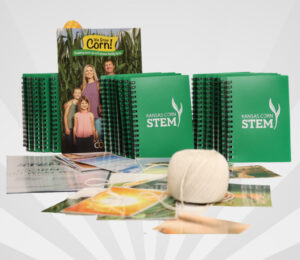Free Classroom Kit
Kansas Corn: World Wide Web
Grade Level: 5th Grade
 Based on direct observation and inquiry, students learn the elements of a cornfield ecosystem, model the relationships among organisms through food chains and food webs, showing how matter and energy move through a system. They investigate the human roles in agricultural food webs, and explore STEM careers in agronomy.
Based on direct observation and inquiry, students learn the elements of a cornfield ecosystem, model the relationships among organisms through food chains and food webs, showing how matter and energy move through a system. They investigate the human roles in agricultural food webs, and explore STEM careers in agronomy.
Quick Links
About Kansas Corn STEM
Investing in Kansas teachers and students is a priority for the Kansas Corn Commission. We are committed to providing materials and training to support STEM education while fostering an understanding of how corn farming and agriculture fit into our daily lives. All K-5 lessons come with a free teacher kit that includes the teaching materials needed for each lesson.
Request MaterialsThis lesson is the work product of the Kansas Corn Commission. Our lessons are written in collaboration with Kansas teachers for use in the classroom. Teachers may copy and share this curriculum. Use of this product for commercial or promotional use is prohibited without express permission of Kansas Corn.
Newsletter Sign Up
Each quarter we release a newsletter written by teachers for teachers. This is an easy way to keep up with what is happening at Kansas Corn STEM.
Subscribe Today!